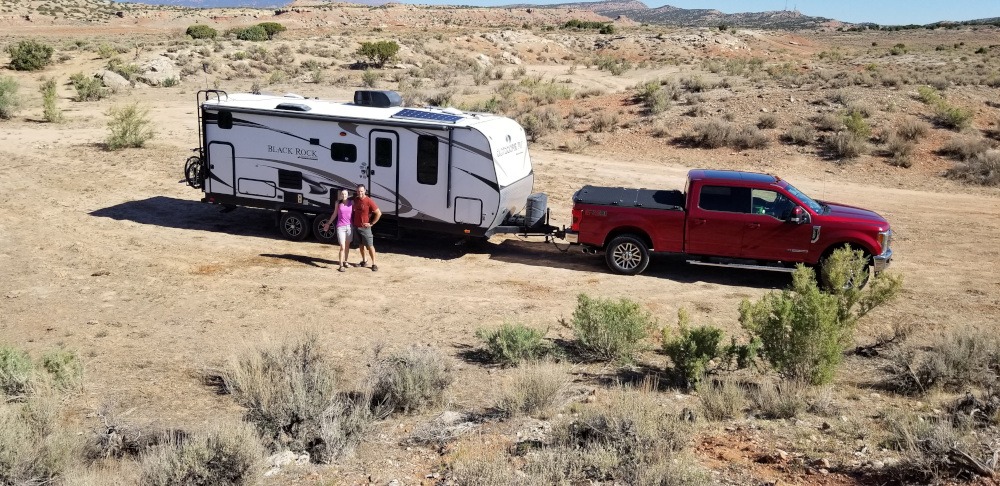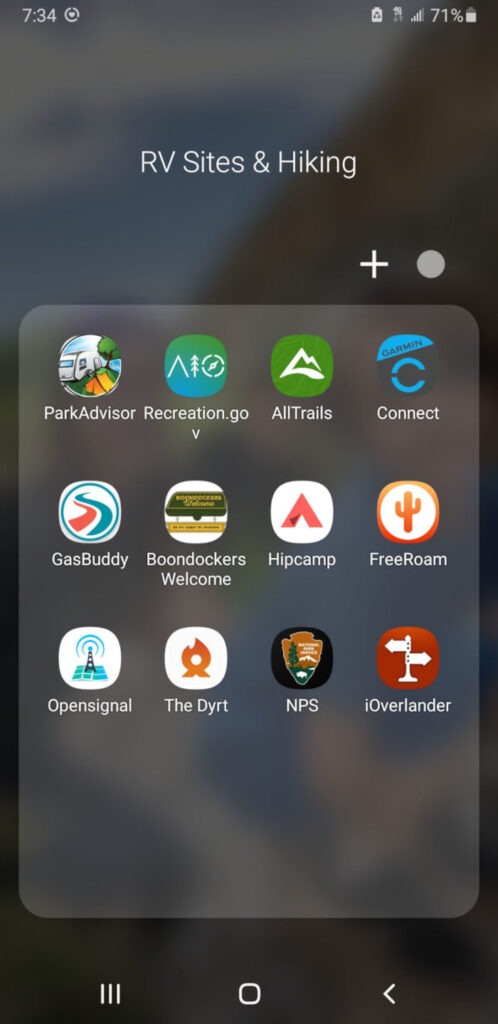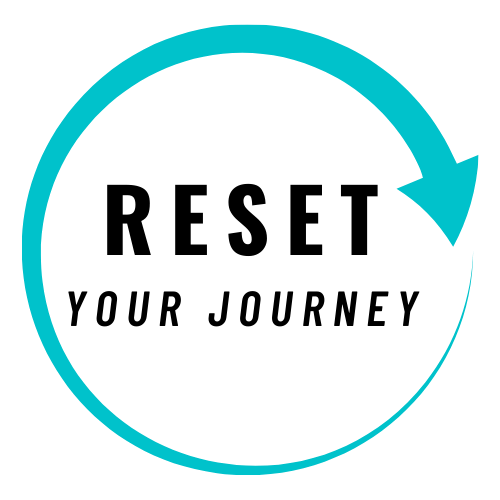Last Updated on 06/22/2024 by Glynn Willard
Let’s cut right to the chase. After boondocking for the majority of our “journey reset,” we’ve figured out what one needs and really doesn’t need if you’re boondocking while living fulltime in an RV.
Let’s take a look. My objective is to help you save weight and money, not encourage you to buy junk you don’t need.
This is the stuff I wish someone had laid out when I was getting started. Wait, there was on resource that I gobbled up. It was no BS, tried and true info.
And it played an instrumental role in our preparations. It’s boondockersbible.com. But before you switch sites, read on. Then check them out when you’re done.
14 Things You Need For Boondocking Fulltime
A small agile RV

If your intention is to predominantly boondock, a large palatial RV limits your ability.
Some of the best spots require high ground clearance and the ability to maneuver in tight spaces.
We’ve found that our 28′ long Outdoors RV is about perfect. It has a high ground clearance and great off-road suspension. Our tow vehcle is a 4×4 Ford F2550.
I would be unwilling to find some of the spots where we camp is we were any larger.
A 4×4 Class B van, Jeep and off-road pop up or truck camper might just be the ultimate boondocking vehicles. Although, their small size limits water capacity.
More about water
Water, water, water!
I can’t stress this enough! Regardless of whether you live in a van or giant Class A, you need a way to store water. As I write this, I’m boondocked near Moab, UT.
And while wandering around town, I keep seeing shirts that say “water is life.” Well, it’s the truth.
For drinking, cleaning and showering, you’ll need approximately 3 gallons per person per day. So, if you have 4 people and want to boondock for 7 days, you’ll need a minimum of 80 gallons.
The likelihood of four people living in a van is slim. So, more than likely you’ll be in a larger RV with sufficient water storage.
OK, so you just looked at that great Jayco “bells and whistle” mobile and it only has 40 gallons of water storage. Stop right there if you’re a family of three or more and your primary objective is boondocking. It will not be a great boondocking vessel.
You’re intelligent enough to do the math before buying the wrong RV.
I also suggest carrying additional water as an emergency backup. We use these Scepter tanks and store them in the truck bed. Although not “truly” bullet proof, they’re bullet proof.
A storage vessel for your poo
Yep, when you gotta go, you gotta go! We’ve learned a few things going down the road (pun intended). So, with three boys/men and one exquisite lady, the guys pee outside, period. And we make full use of public bathrooms.
I even go outside if I wake up in the middle of the night. Seriously, where we stay the stars are amazing!
We found that 40 gallons in the black tank over 7 days never completely fills up.
And for our gray water, we wash dishes over a bin and toss it outside. Don’t worry, we use paper plates that we burn and wipe out our other dishes first. And we use a biodegradable dish soap.
We also shower over the same bin (except for the night before dumping) and toss it too. This way we can get over 10 days out of a 40 gallon gray tank.
Regardless, it takes some practice managing your black and gray tanks before figuring out how long your family can go boondocking.
A Dish Pan To Collect Water
That’s right. One can fill up their gray tank very quickly. Or waste water washing dishes. The solution is a bin that fits inside or over your sink.
When you wash dishes with trickling water, the water is trapped in the bin. This water is then used for the remainder of the day to wash dishes (not to rinse) and then tossed end of day.
Use paper plates (they make great kindling when there’s not a fire ban) and wipe pans out with a paper towel before washing to save water and protect the land.
This bin is also used in the shower to collect as much water as possible, which is also tossed outside.
We frequently use our water collected in this bin to extinguish our fires. Again, if there’s no fire ban.
A Power Source
A power source is essential if you want to stay out for more than one night. Batteries discharge rapidly in most RV’s.
In the current times, solar comes to mind immediately for many. BUT, having a lot of solar is heavy and expensive.
And if you want to run the microwave, air conditioning or coffee maker, you’re going to need a lot of heavy and expensive batteries.
Don’t get me wrong. I believe in having solar and a few batteries to run your DC systems (lights, slide, water pump, etc.).
We don’t have anything fancy. Two panels, two batteries and a charge controller. It works great!
When we want to run a space heater, the microwave, the air conditioning or charge our computers, we run two Yamaha inverter generators in parallel. Each weighs around 45 pounds.
Keep in mind that most batteries weigh that much. The generators are easy to maneuver, are quiet and very dependable. And it only takes me a few minutes to set them up.
They’re also very efficient. Generally, we use less than a gallon of gas a day for all of our needs.
Before anyone comments that our generators are loud and obnoxious, please understand that if we even have neighbors, they’re usually 100 yards away or more. Our quiet generators are inaudible to anyone.
Gas For Generator
We keep a 5 gallon gas container in the back of the truck. Whenever we run errands, I swing by and top it off.
Not to prevent running out, but rather as a means to dump our trash somewhere that we patron.
“Get unstuck devices”
If you boondock, it’s not if, but when you get stuck. So before you hit the road (dirt road), learn the capabilities of your vehicle and the methods of freeing yourself from “sticky situations.”
There are all kinds of tricks. And there’s also all kinds of devices to have on hand that can help.
We’ve found the Campco leveling blocks that look like Lego’s to work remarkably well under the wheels if we’re stuck. They’re small, light and inexpensive. Of course, we need them for our stabilizers anyway.
They’ve gotten us out of a “bind” on several occasions.
Again, learn some methods and tricks before embarking on your boondocking adventure.
Shovel And Leveling Devices
Boondocking land is uneven. And if you want your propane based fridge to work correctly, you need to be somewhat level. Besides, who wants to sleep on an angle.
There are a lot of devices. And bigger, more luxurious rigs have automatic leveling systems. But they can’t go where we go. And sometimes they fail.
So, we’ve found a shovel, a level and the Anderson leveling blocks to be all we need.
All three are inexpensive, easily attainable and work great. We shot a video about all the tricks we use leveling a travel trailer. It might be helpful to watch.
Apps For Finding Locations

My arsenal of apps to find camping, water, dump, diesel and cell signal.
Amazing locations are hidden. And before apps, it was by word of mouth that people knew about any great locations. And usually just locals.
But now, all the great apps have led to saturation of some of the most popular boondocking locations. It’s good and it’s bad. That’s a topic for another time.
We have found the following apps to be instrumental in finding our boondocking locations:
- Freeroam.app
- iOverlander
- Google Maps
- Open Signal
- Boondockers Bible.com
This is an amazing resource that I completely digested before setting out on our journey. We owe Steve and his crew a debt of gratitude!If you plan on this lifestyle, use our information combined with theirs and you’ll be good to go!
Outstanding to find locations within your cell coverage and solid reviews of each location.
Excellent for finding locations to camp and potable water and dump stations.
Once you have the coordinates from the other apps, looking at a satalite view can confirm if your rig will fit as well as directions.
Once you arrive, you can get a picture of the direction to the cell tower. It helps to check this before heading down a dirt road to see if you need to stay close to the entrance or keep going.
I find plans A, B and C before setting out on a move. In doing so, I’ve looked at the satellite overview to familiarize myself with the turns and terrain.
As stated above, I’ve made sure a signal for our cellular carriers is available.
And I’ve found all the locations close by to dump our tanks and acquire potable water for boondocking.
Baby Wipes
Conserving water means showering a few times a week, not daily. This means you have to clean the “hot spots” somehow. Enter baby wipes!
They work great for wiping the dirt off your feet and eliminating the stink between showers. They also burn easily if you burn your paper materials.
Lysol Wipes
The places we stay are dusty. And kids leave a mess. Of course, Rose and I never make a mess… anyway.
We’ve found that since we’re conserving water, the generic version of Lysol wipes work great to clean the entire rig.
It takes less than 20 minutes to sweep or vacuum the rig and clean everything off including the floor with Lysol wipes. And they also burn easily.
They’re lightweight, inexpensive and keep our rig clean. I clean the rig every morning that we move, so that we arrive with a clean fresh house!
Cell Signal Amplifier, Hotspot or Starlink
Either your independently wealthy or you’re working from the road. So, this goes without say that you need some way to connect to the internet or other people.
We use the apps mentioned above to find locations within the range of our cellular carrier.
We also have a weBoost in case we have to stay further from an antenna.
If you’re fortunate enough to have Starlink with the new roaming feature, you’re golden. We’re not there yet. But I’m sure we will be soon.
Either way, you have to have a device to stay connected if for no other reason than to find your next boondocking location.
All Repair Tools

I list many of the tools we keep on hand in our article about uneven tire wear on a travel trailer. You will always have some kind of maintenance to do on your rig in this lifestyle.
And things will break. The old Boy Scout motto of “Be Prepared” is legitimate when you live your life boondocking.
Click to the picture above and come back to this article, because the list goes beyond a ratchet set and screw driver.
We’ve spent a lot of time repairing and maintaining our rig! Not because it’s poorly built, but because we push it to the limits.
A “care about the environment” attitude
Yes, you have to treat the surrounding environment with love and compassion. You’re only borrowing it until the next person comes along to camp there. Leave it better than you found it for them.
We clean up a lot of junk on the land from trash to gun shells. Yes, we shoot, but we leave no trace when we’re done.
If we abuse the land, others can’t enjoy it and government agencies will find ways to take it away. And dag nabit, we pay taxes for the use of this land. Take care of it!
What We Don’t Need For Fulltime Boondocking!
- A large Camp Chef
- A massive off-grid solar array
- Lots of lawn furniture
Get the smallest outdoor stove you can that’s easy to move, light weight and easily accessible. Otherwise, it never finds its way out of storage.
You can get by just fine (and save a lot of money) on a small solar array, small battery bank and a couple small generators run in parallel. Minimal money, minimal fuel and all the pleasures of a sticks and brick home.
It’s nice to have, but you’ll worry about it when you leave the rig to check out the sights. Light weight and easily accessible is the key.
How often do you boondock living fulltime in an RV?
Happy and safe travels!
Meet the author.
We appreciate any help we can get to bring you great content. Donate or buy us a coffee on our Ko-Fi site.













